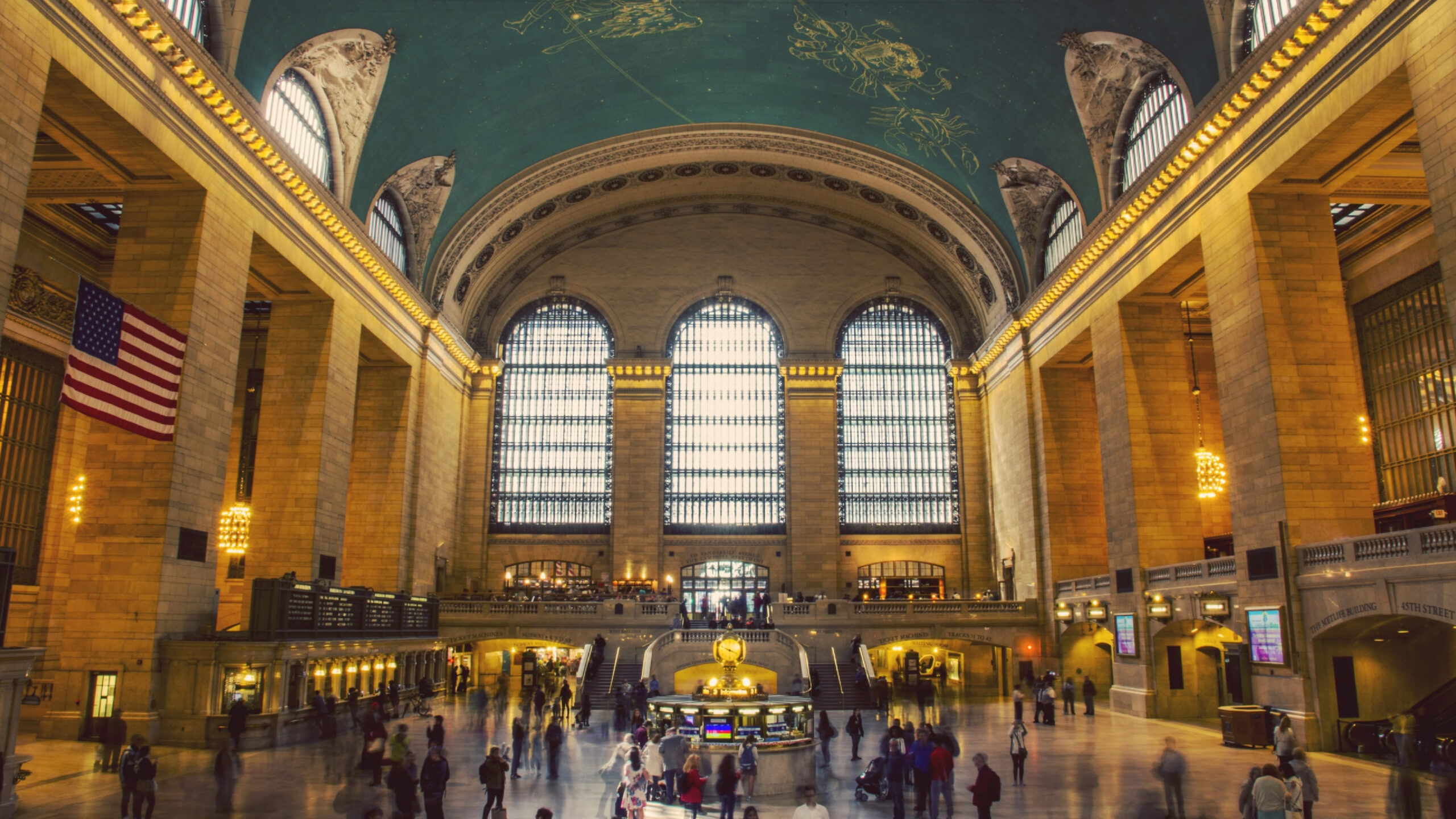
| Subtotal | $0.00 |
|---|---|
| Taxes | $0.00 |
| Total Cash or Debit | $0.00 |

Whether a daily commuter or a first-time visitor, a stop at Grand Central Terminal is certainly on your agenda (right after a licensed dispensary visit, we hope). Good thing, too, because you won’t want to miss this beautiful historic hub that brings a generations-spanning legacy. Let’s get to know this travel destination by taking a deep dive into its historic high points.

Grand Central wasn’t always a Terminal. In fact, there were two predecessors that had their foundation on 42nd Street.
The original Grand Central opened in September 1869. Back then, there were multiple railroads running on their own time, which didn’t help riders who wanted to commute efficiently with all their luggage. So, the Grand Central Depot made mergers to create the Hudson River Railroad, the New York and Harlem Railroad, and the New York and New Haven Railroad. Travelers rejoiced.
But it wasn’t always smooth sailing. In fact, there were so many accidents where people and trains collided that in 1874 an underground tunnel was dug starting at 96th Street so trains could pull into the Depot without interrupting traffic.
By 1897, 11.5 million people traveled through the Depot each year, which is a little less than the whole population of modern Belgium. Needless to say, it became a bit cramped. The Depot had to be remodeled with a reconstructed waiting room and got its new and oh-so-different name: Grand Central Station.
However, those renovations still weren’t enough to accommodate the City That Never Sleeps. Tons of train smoke clogged the tunnels which inevitably, and unfortunately, caused a pretty big train crash in 1902.
In 1903, William J. Wilgus, New York Central’s VP, took over with an electrifying proposal: tear down this steamed-up joint and replace it with something much grander and safer.
Wilgus was a man of vision. His main focus points were to electrify everything in the early days of electricity and build two levels of tracks. But, since this is New York City, it also had to look good, so multiple architects were called in to combine then-modern technology and style.
Aside from hub-wide electrical track improvements that did away with the smokey tunnels, the infamous third rail, the electrified piece of track, was implemented. It was only invented a few years before in 1879 in Germany, and an updated version is still in use. The electricity didn’t end at just the tracks: for example, you can still admire the hub-wide gilded chandeliers today.
Welcome to the new Grand Central Terminal. All this splendor was intended to compete with the original New York Pennsylvania Station — which, is not the one that’s in use today. Overall this grand renaissance construction was estimated to cost $180 million, the equivalent of more than $5 billion today. That’s billions, with a B.
All aboard. 150,000 travelers visited Grand Central Terminal on opening day, February 2nd, 1913. The main concourse became a masterpiece in itself, spanning 35,000 square feet, all floored with pink Tennessee marble.
The city is famous for its architecture, even in the most unexpected spots. So it comes to no surprise that something as seemingly ordinary as a railroad offers the same splendor as a grand ballroom.
Gilded sculpting all around: French sculptor Sylvain Saliéres was called in to adorn almost every inch of the Terminal. Fancy metalwork designated the elevators, the letters G, C, and T overlap each other within designs throughout, and he added acorns everywhere he could. Why acorns, you may ask? It’s the calling card of business magnates the Vanderbilt family.
The two clocks: The famous information booth crown was built by the Seth Thomas Clock Company and its four faces were constructed with milk glass. On top of that sits another acorn. The original clock is in a museum and the one you see in the terminal today is a replica. The beautiful clock you see outside one of the main Terminal entrances is supposedly the Tiffany company’s largest clock ever, at 14 feet tall.
The Big Board: The original display of the train times in the main concourse, lovingly dubbed The Big Board, lasted until 1967. But, it was subsequently updated four more times to keep up with the latest tech advancements.
The famous ceiling: The ceiling you see today is a cleaned-up addition from 1944, which is a less detailed version of the 1913 original; unfortunately, that one became too water-damaged. The constellations are painted backward, but the Vanderbilts conveniently had a reason for that: the ceiling was meant to be viewed from a “divine perspective.”
Grand Central Terminal continued to flourish, but then an event that would stop the world took place. During World War II, the concourses’ windows were blackened with paint to prevent aerial bombers from easily detecting and targeting the building. The train hub also became a station for USO personnel and housing a canteen. Even though it had to adapt one more time, Grand Central served its travelers when they needed it most.
Railroads aren’t without roadblocks. Grand Central Terminal was once close to filing for bankruptcy and also was threatened to be demolished and replaced with a skyscraper. This was around the time the original Penn Station was torn down, causing concern that Grand Central could come down next.
But, in 1967, Grand Central Terminal was declared a landmark. Still, it wasn’t safe — yet. In 1976, Jackie O. (yes, her!) rallied to keep it as such since the skyscraper business was still a topic of discussion. No spoiler alert is needed that she put the kibosh on that once and for all. But as we can see today, there was a sky-high addition to the Terminal. The Pan Am Building, AKA the MetLife Building today, was built right on top, adding another tower to the city skyline.
GCT has gone through multiple, multi-million rounds of historic restoration and modern renovations. Still, Grand Central never stops evolving. In 2023, it expanded to connect the Long Island Railroad (LIRR) with its new Grand Central Madison station that is located just below the original Grand Central Terminal.
Today, more than 750,000 pass through Grand Central on their way in and out of the city. Its ideal Midtown East location is home to eateries, corporate offices, shopping, and of course, dispensaries. But if you’re in a rush to get your green, we have an easier solution for you: Hop on the 4/5/6, which stops directly at Grand Central Terminal, and get dropped off at Union Square — and The Travel Agency — in minutes.
With a building of such history, you better believe it has some secrets to share, too. You may already know of the Whispering Wall and Track 61 that was used once by VIP Franklin D. Roosevelt (and…Andy Warhol we hear?), but there are some other historic hush-hushes that bring appreciation of this iconic landmark to a new level.
M42: This is a secret tunnel and exists on no map. M42 was first used in World War II, its location kept a secret to dodge enemy spies who could use it to disrupt rail travel. Today, it houses converters and is responsible for all electricity in the Terminal, which is significantly more boring (but still important) than its history.
Campbell Apartment: This apartment, which is more like a super VIP-sized office space, used to belong to John C. Campbell, a business tycoon who needed a more convenient spot to meet clients. Just like most things in NYC, it houses a pretty fancy bar today.
Window Walking: If you’re employed in the offices above GCT, you have special permission to walk through the giant windows to work via built-in glass walkways. Supposedly it’s so you don’t have to get caught up in the Terminal’s people traffic, but this privilege feels like a hidden city superpower.
Showtime: A movie theater used to call GCT home. The Grand Central Theatre was built in 1937 near Track 17. With 242 seats and a bar, commuters passed the time waiting for their next train. For your sightseeing tour, you can still spot it by its remaining blue sky mural, which was meant to match the Terminal’s original ceiling.
As you rack up your frequent flyer miles in New York City, take a moment to gaze up at the stars as millions have on their commutes, during political rallies, memorials, and sports championship celebrations. If this city never sleeps, Grand Central Terminal is the caffeine — or dare we say, cannabis? — that keeps it going. The 4/5/6 easily connects The Travel Agency to GCT, so if you’re planning to leave the city for a getaway, picking up relaxing edibles for your train journey is made easy.